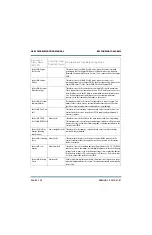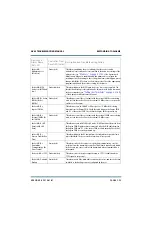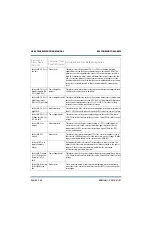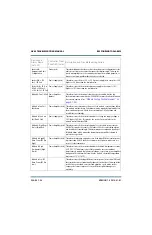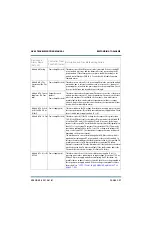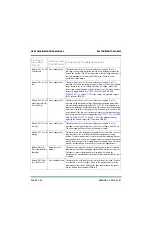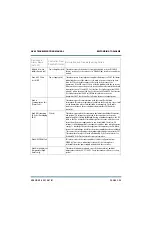
GV60 TROUBLESHOOTING MANUAL
RESPONDING TO ALARMS
PAGE 4.1.14
VERSION 1.0 2018-01-01
Controller: Host Not
Booted
Exciter (amber)
This alarm indicates that the controller’s host has not finished booting. The
remote AUI will not yet be available. This alarm normally occurs with an ac
loss or software upgrade. It will clear when the host completes booting.
Controller: Host Not
Responding
Exciter (red)
This alarm indicates that the controller’s host is not communicating with the
rest of the transmitter. If the watchdog function is enabled, the DSP will
automatically reset the host. If this alarm persists, the controller may
require reprogramming or replacement. If necessary, replace the single
board computer (A4A1) (see
).
Controller: Local UI
Failure (UI Failure)
Exciter (red)
This alarm occurs if there is a fault with the LCD user interface (UI),
preventing it from being used to control the transmitter. The transmitter will
automatically switch to remote control mode to allow use of the AUI or
digital I/O.
Controller: Low AC
Operation
Power Supply (red)
This alarm occurs if the ac input voltage is less than 175 V ac, but greater
than 90 V ac. Transmitter RF output power will be limited to approximately
33% of maximum power or to the current setpoint, whichever is less.
Controller: Low
Battery
Exciter (amber)
This alarm occurs if the backup battery voltage falls below an acceptable
level (2.7 V). The GV60 takes no action on this alarm. Use a digital
multimeter to measure the battery voltage (with ac power on). If the battery
voltage is low, replace the battery. If battery voltage is OK, cycle ac power
(off, then on). If the alarm does not clear, check the controller PWB (A4A2).
Controller: Low
Battery/Memory
Summary
Power Supply (red)
Not displayed in AUI or UI status. Configurable as a remote output.This
alarms occurs if there is a specific battery or memory related alarm present.
Check for specific alarms and troubleshoot accordingly.
Controller: Low
Efficiency
Output network
(amber)
This alarm occurs in conjunction with the Combiner Match alarm to indicate
that the transmitter is exhibiting low Dc-RF efficiency.
Controller: Low
Forward Power (Low
Fwd Power)
Output Network
(amber)
This alarm occurs if the transmitter’s average forward power is below the
low forward power threshold (defaulted to 50% of the setpoint and is user
adjustable). Check for associated alarms and follow the associated
troubleshooting procedure, if applicable.
Controller: Low RF
Drive
Exciter (red)
This alarm occurs if the RF drive power from the exciter is less than the low
threshold (70% of the setpoint). This may be the result of a calibration
problem with either the exciter or the transmitter RF drive sample. Check all
connections to the exciter. Check the RF drive connection between the
exciter RF output and the RF drive splitter input.
Device and
Alarm Name
(AUI, UI)
Controller Front
Panel LED (color)
Description and Troubleshooting Action
Summary of Contents for GV60
Page 2: ......
Page 4: ......
Page 8: ...GV60 TROUBLESHOOTING MANUAL PAGE 4 VIII VERSION 1 0 2018 01 01 ...
Page 102: ...GV60 TROUBLESHOOTING MANUAL PARTS LISTS PAGE 4 2 12 VERSION 1 0 2018 01 01 ...
Page 463: ...VERSION 1 0 2018 01 01 MD 17 Figure MD 17 NAPA31C Power Amplifier PWB Q1 ...
Page 475: ...GV60 TROUBLESHOOTING MANUAL LIST OF TERMS PAGE 4 6 2 VERSION 1 0 2018 01 01 ...
Page 476: ......























